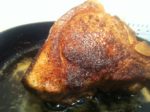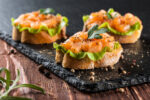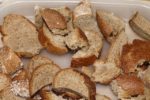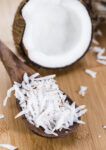
Using Coconuts for Cooking
Coconuts were used to produce a variety of interesting dishes. But you couldn’t buy coconut already shredded in grocery stores. You bought the whole coconut, cracked it, and shredded it yourself.
INFORMATION BELOW FROM 1800s COOKBOOKS
The coconut is perhaps the most important of all the shell fruits. The fruit is eaten raw and is prepared for food in many ways. It also yields an oil which forms an important article of commerce.
The milk of the fruit is a cooling beverage, and the woody shell of the nut answers very well for a cup from which to drink it. The saccharine juice of the tree also affords an excellent drink, and from the fresh young stems is prepared a farinaceous substance similar to sago.
Picked fresh from the tree, the coconut consists first of a green outer covering, next of a fibrous coat, which if the nut is mature, is hairy-like in appearance, and then of the woody shell, inside of which is the meat and milk.
For household purposes, the nuts are gathered while green and before the inner shell has become solidified. The flesh is then soft like custard and can be easily eaten with a teaspoon, while a large quantity of delicious, milk-like fluid is obtainable from each nut.
The coconut is difficult of digestion, as is likewise the prepared or desiccated coconut. The coconut contains about seventy per cent of oil.
COCONUT MILK AND CREAM
Select good coconuts with milk in them. Let the milk out of the soft eye, then holding the nut in the left hand, strike sharp, quick blows with a hammer or iron bar on the meridian line, causing the nut to revolve by tossing it up slightly, when it will break in halves.
Grate on an iron or steel coconut scraper, placing the scraper board across a chair, with a pan upon the floor to catch the grated nut.
For each grated nut, pour over a quart of hot water. Stir well, then squeeze and strain through a strong, coarse cloth.
Empty the coconut from the cloth into a saucepan, pour over a little more hot water, stir, and strain through the cloth a second time to get out all the milk. This makes coconut milk. Use coconut milk for vegetable or pudding sauces or in almost any way that dairy milk is used. Stir before using.
Using half the quantity of water makes good cream, or let the milk stand an hour and skim off the top for thick cream.
COCONUT BUTTER
Place the milk on ice for a few hours and the butter will rise to the top and can be skimmed off.
COCONUT OIL
Coconut oil can generally be purchased in the market from wholesale druggists, though it is sometimes difficult to get that which is not rancid.
It can be made by taking the cream from a half dozen or dozen nuts, treated as above, only allowing the milk to stand over night before skimming. Boil the cream in an iron vessel without stirring until all the water is evaporated.
When done, the sediment will be found browned and adhering to the bottom of the vessel. Bottle, and set away for use.
SHREDDED COCONUT
Put any left-overs of prepared coconut on a plate and set in the sun or near the stove to dry. Keep in glass jars in a dry place. This unsweetened coconut can be used for shortening and in many places where sweet is not desirable.
CCOCONUT PUDDING
Having opened a coconut, pare off the brown skin from the pieces and wash them all in cold water. Then weigh three-fourths of a pound and grate it into a dish.
Cut up half a pound of butter, add to half a pound of powdered loaf sugar* and stir them together to a cream. Add to them a glass of wine and rose water mixed. Beat the whites only of twelve eggs till they stand alone on the rods.
Then stir the grated coconut and the beaten white of egg alternately into the butter and sugar, giving the whole a hard stirring at the last.
Put the mixture into a buttered dish, lay puff paste round the flat edge, and bake it half an hour in a moderate oven.* When cool, grate powdered sugar over it.
*loaf sugar – sugar sold in a hard block, which has to be broken and then pounded into sugar granules
*moderate oven – about 350-400 degrees Fahrenheit.
BAKED COCONUT CUSTARD
Grate as much coconut as will weigh a pound. Mix half a pound of powdered white sugar with the milk of the coconut or with a pint of cream, adding two tablespoons of rose water. Then stir in gradually a pint of rich milk.
Beat to a stiff froth the whites of eight eggs and stir them into the milk and sugar, a little at a time, alternately with the grated coconut. Add a teaspoon of powdered nutmeg and cinnamon, put the mixture into cups, and bake them twenty minutes in a Dutch oven half filled with boiling water. When cold, grate loaf sugar over them.
COCONUT MACAROONS
Beat to a stiff froth the whites of six eggs, and then beat into it very hard a pound of powdered loaf sugar. Mix with it a pound of grated coconut or sufficient to make a stiff paste. Then flour your hands, and make it up into little balls.
Lay them on sheets of buttered white paper, grating loaf sugar over each, and bake them in a hot oven.* They will be done in a few minutes. Macaroons may be made in a similar manner of pounded ground-nuts, filberts, or English walnuts.
*quick oven / hot oven – about 400-450 degrees Fahrenheit.
WHITE COCONUT CAKE
Break up a coconut, peel and wash the pieces in cold water, and grate them. Mix in the milk of the nut and some powdered loaf sugar and then form the grated coconut mixture into little balls upon sheets of white paper. Make them all of a regular and handsome form. Do not bake them, but place them to dry for twenty-four hours in a warm room where nothing is likely to disturb the them.
COCONUT JUMBLES
Grate a large coconut. Rub half a pound of butter into a pound of sifted flour, and wet it with three beaten eggs and a little rose water. Add by degrees the coconut, so as to form a stiff dough. Flour your hands and your paste-board and divide the dough into equal portions.
Make the jumbles with your hands into long rolls, and then curl them round and join the ends so as to form rings. Grate loaf sugar over them, lay them in buttered pans, (not so near as to run into each other), and bake them in a quick oven from five to ten minutes.
COCONUT SOUP
Take eight calves’ feet (two sets) that have been scalded and scraped, but not skinned. Put them into a soup-kettle with six or seven blades of mace, and the yellow rind of a lemon pared thin. Pour on a gallon of water, cover the kettle, and let it boil very slowly (skimming it well) till the flesh is reduced to rags and has dropped entirely from the bones. Then strain it into a broad white-ware pan, and set it away to get cold.
When it has congealed, scrape off the fat and sediment, cut up the cake of jelly (or stock), and put it into a clean porcelain or enameled kettle.
Have ready half a pound of very finely grated coconut and mix it with a pint of cream. If you cannot obtain cream, take rich unskimmed milk and add to it three ounces of the best fresh butter divided into three parts, each bit rolled in arrow-root or rice-flour.
Mix it gradually with the coconut and add it to the calves-feet-stock in the kettle, seasoned with half a grated nutmeg. Set it over the fire and boil it slowly, about one-fourth hour, stirring it well. Then transfer it to a tureen and serve it up.
Have ready small French rolls or light milk biscuits to eat with it, along with powdered sugar in case any of the company should wish to sweeten it.
Image from Deposit Photos
=================================================
How Do You Use Coconut? Please Leave a Comment Below.
=================================================



